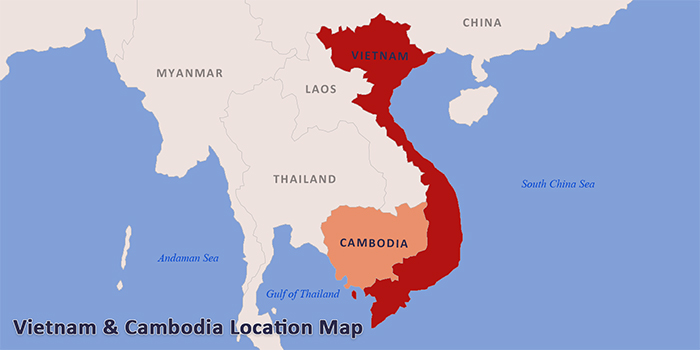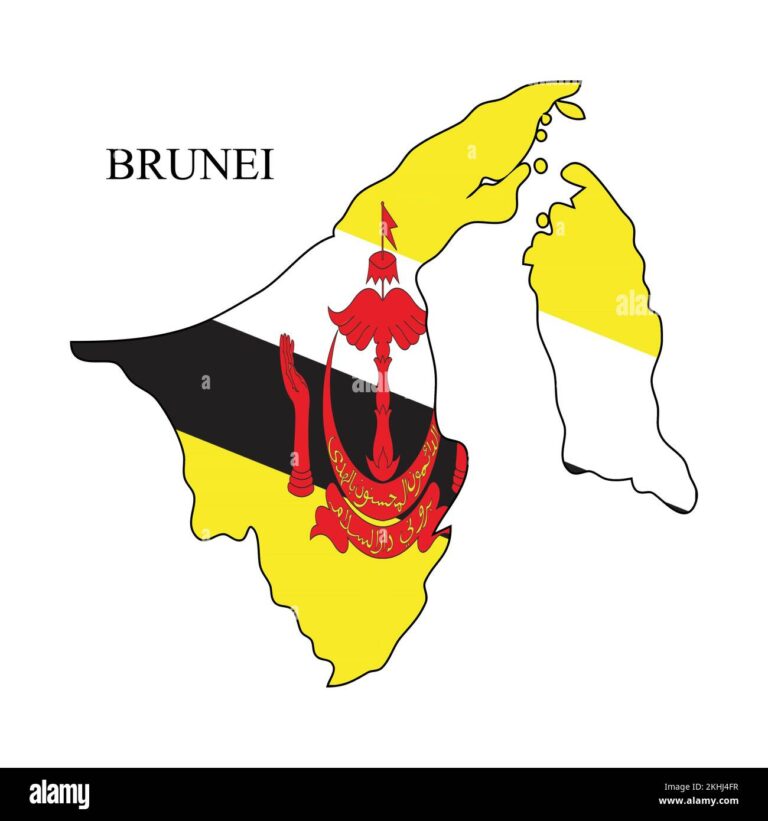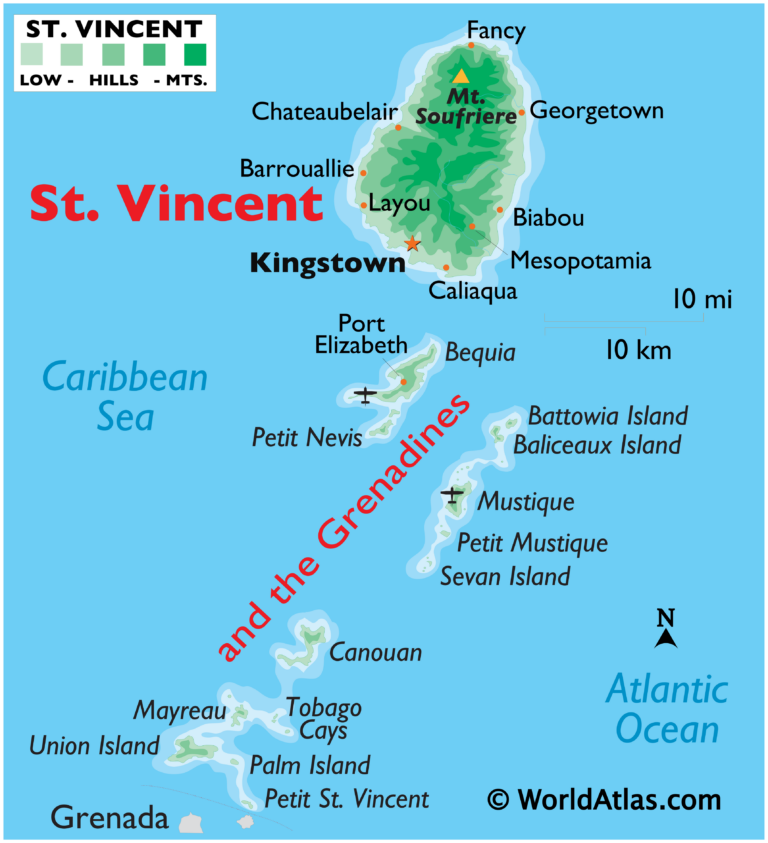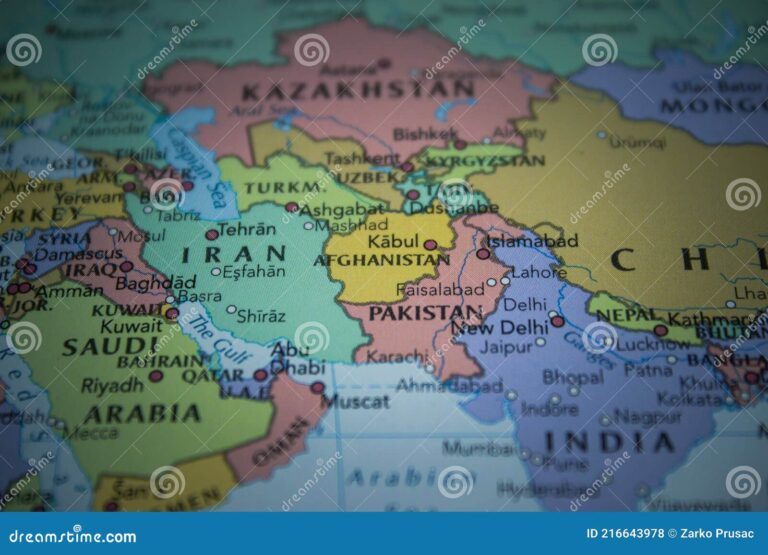Cambodia Neighbouring Countries on the Map

Cambodia’s Neighbors
Thailand
When it comes to Cambodia and its western neighbor, Thailand, you’re looking at a relationship that’s complicated but interesting. Imagine two old friends who know each other’s business, sometimes taking jabs but also helping each other out. They share a history that goes way back, though their diplomatic rapport can be as unpredictable as weather forecasts.
Border Length and Characteristics
This border stretches for 508 miles, running through both dirt and water. It’s not all friendly waves across the fence, though. They’ve got some head-scratchers to solve, like where exactly their maritime claims meet in the Gulf of Thailand, a place known to hide a good stash of natural gas. There’s been chatter, especially after the 2001 handshake deal, about buddying up for exploration (East Asia Forum).
| Border Characteristic | Detail |
|---|---|
| Length | 508 miles |
| Key Issues | Overlapping maritime claims, natural gas reserves |
Economic and Diplomatic Relations
Ever since Yingluck Shinawatra took the wheel in Thailand back in 2011, the two countries have generally played nice. Even after Thailand’s government shake-up in 2014 and the trickier times with Cambodian workers, they’ve found ways to keep cash and goodwill flowing. Their economic connection is anything but minor, focusing particularly on the Southern Economic Corridor, boosting the Greater Mekong Subregion (East Asia Forum).
However, people were expecting more paper to change hands, but their trade and investments have been kinda meh compared to others in the neighborhood. Time to turn up the heat on these business exchanges.
| Economic Activity | Detail |
|---|---|
| Key Trade Routes | Southern Economic Corridor |
| Financial Systems | Interoperable payment remittance |
Want more skinny on the whys and hows of their diplomatic dance? Take a look at our pieces on territorial disputes and global trading systems.
Laos
Now to the northeast sits loyal old Laos, quiet and tucked away. Sure, it might not hog the limelight, but their bond with Cambodia is solid. Laos doesn’t have a beach to boast about, and that influences how they roll with trade and logistics.
Border Length and Characteristics
Their shared stretch of land runs 345 miles, all tangled in hilly jungles. It’s no smooth ride! Laos being landlocked makes for interesting challenges and chances in the cross-border trade game.
| Border Characteristic | Detail |
|---|---|
| Length | 345 miles |
| Terrain | Rugged and forested |
Economic and Diplomatic Relations
With history as their glue, Cambodia and Laos maintain a no-drama relationship. Their mission? To get cozy under the ASEAN umbrella and boost the economic pulse of the region.
The Laotian border holds promise like a blank canvas waiting for paint—transport and logistics could be the brush strokes enhancing the connectivity of this area.
For more juicy bits about how Cambodia gets along with Laos and others nearby, check our detailed articles on ASEAN integration and economic trends.
Cambodia’s ties with Thailand and Laos form a tapestry of history, economy, and diplomacy. These connections are key threads in Southeast Asia’s geopolitical fabric. Curiosity piqued? Spend some time exploring neighboring countries in other parts of the world.
Borders and Land Characteristics
Exploring Cambodia’s borders and land gives a peek into how it mingles with its neighbors like Laos, Thailand, and Vietnam, plus the Gulf of Thailand. Let’s check out the border lengths and the main features of its landscape.
Border Lengths
Cambodia cozies up with three nations: Laos, Thailand, and Vietnam, along with the Gulf of Thailand coast. Altogether, its land touches total around 1,572 miles.
| Neighboring Country | Border Length (miles) |
|---|---|
| Thailand | 508 |
| Laos | 345 |
| Vietnam | 720 |
Thailand
Cambodia snuggles up to Thailand for 508 miles. The Dangrek Mountains help set these two apart, acting like a natural wall between them.
Laos
To the northeast, Laos links arms with Cambodia, stretching 345 miles. Laos stands out as the only landlocked spot in Southeast Asia, adding a twist to its neighborly connections.
Vietnam
Vietnam and Cambodia share a substantial 720-mile hold. This border sprawls mostly east and south, crossing highlands, the beauty of the Mekong Delta, and the more flat central lowlands. Plenty of roads keep things flowing between them.
Physical Features
Cambodia’s got a lot going on—it’s dotted with mountain ranges, wide deltas, and even boasts a solid stretch of seaside fun along the Gulf of Thailand.
Mountains and Plateaus
- Dangrek Mountains: Shapes the boundary with Thailand.
- Cardamom Mountains: Toward the southwest, making the land rugged and wild.
- Eastern Plateau: Lifts up in the east, skirting along Vietnam.
Rivers and Deltas
- Mekong River: A mighty river threading through Cambodia from north to south, critical for its vibe.
- Tonle Sap Lake: A major freshwater gem tied to the Mekong, known for its rhythm of flooding and fishing life.
Coastline
Cambodia enjoys about 275 miles of coastline along the Gulf of Thailand, sprinkled with over 50 islands. This stretches out a chance for rich marine life and boosts tourism dreams.
Getting a handle on these borders and nature’s quirks helps make sense of Cambodia’s connections with its neighbors and how it plays out in things like foreign policy and economic ventures.
Relations and Foreign Policy
So, Cambodia’s taken the chessboard of trade—both local and beyond—to set itself on the victory path for growth. It keeps chummy with neighbors like Thailand and Vietnam, because, hey, friendly fences make good markets!
ASEAN Integration
They went all-in with ASEAN, that cool club for 10 Southeast Asian buddies who try to keep business boomin’ and the peace peaceful. This membership is Cambodia’s passport to sweet deals and smoother political waters with Table Buddies like Thailand and Laos.
Being part of ASEAN is like a gift basket for Cambodia:
- Trading Tango: Smoother roads for selling and buying stuff without getting pinched too much on taxes.
- Keeping Calm and Carrying On: A big ol’ group hug of security to help sort things out when they get sticky.
- Meet and Greet: More chances to show off their culture and boost tourism. Who wouldn’t want that?
ASEAN Membership Table:
| Country | Year Joined |
|---|---|
| Thailand | 1967 |
| Laos | 1997 |
| Cambodia | 1999 |
Want to learn more? Dive into Cambodia’s ASEAN integration with our piece on afghanistan neighboring countries.
Global Trading Systems
Cambodia jumped aboard the WTO ship in 2004, a ticket marked “serious about trading.” Joining meant gaining a golden ticket to international markets and securing a seat at the table to protect its trading future.
Here’s how Cambodia plugs into the global trading buzz:
- Selling More, Reaching Further: Sending out everything from clothes to crops across the globe.
- Show Me the Money: Wooing investors to pour cash into new factories and roads.
- Deal Makers: Signing up for trade deals as a way to buddy up economically.
The numbers don’t lie:
| Sector | Contribution to GDP (%) |
|---|---|
| Tourism | 16 |
| Textiles & Garments | 30 |
| Agriculture | 30 |
For the full scoop on Cambodia’s trade hustle, don’t miss our article about argentina neighboring countries.
By dancing with both local and global trade partners, Cambodia is not just cashing in but also making friends for when it counts. That’s like double-dipping into economic barbecue sauce—finger-licking good!
Economic Scene
Taking a peek at Cambodia’s economy shows us how things stack up—not just the achievements but the hurdles too. They’re growing fast, but there’s a way to go compared with nearby countries.
Pocket Money Per Person
Cambodia’s pocket money per person is on the rise, but it’s not quite up there with places like Thailand and Vietnam. They’re making headway, but folks aren’t rolling in cash just yet.
| Country | Per Person Income (USD) |
|---|---|
| Cambodia | 1,600 |
| Thailand | 6,600 |
| Vietnam | 2,600 |
The numbers tell the tale: Cambodia’s improving, but they still need more time to catch up with the Joneses next door. If you’re curious about how other regions stack up, check out our other pieces on Bangladesh neighbors and [Vietnam neighbors].
Big Moneymakers
Cambodia’s bank is backed by big hitters like textiles and tourism, with farming also offering a lifeline for many in the countryside.
Textiles: This is the top dog, bringing in the bacon with exports. Loads of people get their daily bread from this sector, making it crucial for the whole shebang.
Tourism: Coming in strong at number two, tourism makes up around 16% of GDP as of 2006 (Economy of Cambodia – Wikipedia). With attractions like Angkor Wat, it’s easy to see why tourists flock here.
| Industry | GDP Contribution (%) |
|---|---|
| Textiles | ~80 |
| Tourism | 16 |
| Agriculture | 20 |
Apart from textiles and tourism, farming—especially rice—keeps many rural folks afloat. The economy’s branching out slowly, but those two industries still hold the fort.
Getting a clear picture of Cambodia’s economic health helps make sense of its spot among neighboring economies. For more juicy details on other countries, dive into our articles on Angola neighbors and Argentina neighbors.
Historical Background
To get the full picture of how Cambodia’s neighboring countries interrelate, let’s take a trip down memory lane. The stories from the Khmer Empire and colonial times have left quite a mark on Cambodia’s dance with its close pals, Thailand and Laos.
The Khmer Empire’s Echo
The Khmer Empire, strutting its stuff from about 802 to 1431 CE, was the big cheese in Southeast Asia (Britannica). Back in its heyday, the empire stretched its influence to spots now known as Thailand, Vietnam, and Laos.
- Culture and Art: The legacy of the grand old Khmer Empire is stamped all over Cambodia, with jaw-dropping temples like Angkor Wat showing off its design flair and artistic genius.
- Political Systems: Their sharp political systems were no joke and left a deep footprint on how nearby folks ran things.
The Angkor era (9th–15th century) was like a golden-ticket time for Cambodia, as it held sway over places that we now call Thailand and Laos. This chapter was all about fat wallets and mind-boggling cultural feats.
Colonial Era Commotions
After the Khmer Empire decided to take a bow, Cambodia morphed into a petite Buddhist kingdom by the late 1700s, leaning a bit on its muscle-flexing neighbors, Thailand and Vietnam.
- Conflict: The 1800s were rough, with Cambodia stuck between feuding powers Thailand and Vietnam, putting its survival on the line.
- French Protectorate: 1863 rolls around, and King Norodom says, “Save us, France!” from Thai land dreams, leading to Cambodia signing up as a protected territory under the French. This relationship carried on until well into the 1900s.
Being Under and Breaking Free
- Colonial Rule: The French had their say in Cambodia for nearly 90 years, leading to big shifts in how society, culture, and politics played out.
- Independence: Fast-forward to 1953, and under King Sihanouk, Cambodia shakes off French rule, waving its banner as the Kingdom of Cambodia.
Rockin’ and Reeling
- Khmer Rouge Era: 1975 wasn’t the best year, as the Khmer Rouge took the reins, leading to tragic times with over 1.2 million killed.
- Vietnamese Intervention: Vietnam stepped in in 1979 to stop the Khmer Rouge’s havoc, guiding Cambodia through a decade of their own governance.
Piecing together these historical puzzle bits gives us a clearer view of Cambodia’s friendships with its neighbors. These stories highlight the rich, tangled web of power plays, culture, and politics that are still impacting the scene today. If you’re curious about the money trail in these matters, head over to our article on Per Capita Income.
Territorial Disputes
The tussle over where Cambodia stops, and Thailand begins has been going on for what feels like forever, especially around the Preah Vihear Temple area.
Thailand Border Dispute
The Cambodia-Thailand border quarrel is mainly about who gets to brag about owning the Preah Vihear Temple. Back in 1962, the International Court of Justice (ICJ) said “Yup, it’s Cambodia’s!” using a 1907 map (World Atlas). But, they kind of skipped talking about the lands around it, leaving Thailand a bit salty.
Key Drama of the Dispute:
- 1962 ICJ Ruling: ICJ told everyone the Preah Vihear Temple’s Cambodian property by a 9-3 vote.
- Lingering Dispute: The court was mum on the surrounding land, letting Thailand keep its grievances alive.
Fast forward to December 2011, tensions flared once again when gunfire was exchanged after a new Thai government stepped in. Post-battle, both nations thumb wrestled and decided on pulling back their troops.
| Major Moments | What Happened |
|---|---|
| 1962 ICJ Ruling | Told the world Preah Vihear Temple is Cambodia’s |
| 2011 Armed Clashes | Agreed to step back troops from the hotspots |
Resolution Efforts
Both sides have tried playing nice, some more than others. On November 11, 2013, the ICJ doubled down, reminding everyone that the entire promontory of Preah Vihear is indeed Cambodia’s. To keep the peace, Thailand was told to pack up their military toys from the vicinity (Wikipedia). Although, the court left the hill of Phnom Trap (aka Phu Ma-khuea) out of the conversation, dodging another potential brawl.
Resolution Highlights:
- November 2013 ICJ Ruling: Steadfastly confirmed Cambodia’s claim over Preah Vihear’s promontory.
- Troop Pullback: Ordered Thailand to yank its military out of the zone.
Curious about who else rubs shoulders with these countries? Peek at our reads on Thailand’s neighboring countries and Laos’s neighboring countries.



